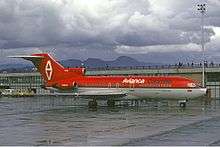Avianca Flight 203
 An Avianca Boeing 727-100 similar to the one involved. | |
| Bombing summary | |
|---|---|
| Date | November 27, 1989 |
| Summary | Bombing |
| Site |
Colombia 4°35′N 74°13′W / 4.583°N 74.217°WCoordinates: 4°35′N 74°13′W / 4.583°N 74.217°W |
| Passengers | 101 |
| Crew | 6 |
| Fatalities | 110 (including 3 on ground) |
| Survivors | 0 |
| Aircraft type | Boeing 727 |
| Operator | Avianca Airlines |
| Registration | HK-1803 |
| Flight origin | El Dorado Int'l Airport |
| Destination | Alfonso Bonilla Aragón Int'l Airport |
Avianca Airlines Flight 203 was a Colombian domestic passenger flight from El Dorado International Airport in Bogotá to Alfonso Bonilla Aragón International Airport in Cali. It was destroyed by a bomb over the municipality of Soacha on November 27, 1989.[1]
The aircraft took off from the Colombian capital Bogotá en route to Cali. It was in the air for five minutes and flying at a speed of 794 kilometres per hour (493 mph) when an explosive charge detonated on board, igniting fuel vapors in an empty fuel tank.
Flight
The aircraft was a Boeing 727-21 with registration number HK-1803, purchased from Pan Am. It took off as scheduled at 7:13 a.m. Five minutes into the flight, a bomb placed near the fuel tank exploded at 13,000 feet. The blast ripped the airliner apart: the nose section separated from the tail section, which went down in flames. All 107 people on board were killed, as well as three people on the ground who were killed by falling debris. According to the investigations the bomb was placed by a man wearing a suit who was able to bring the bomb inside the aircraft in a suitcase.[2]
Aftermath
The bombing of Flight 203 was the deadliest single criminal attack in the many decades of Colombian violence. Pablo Escobar of the Medellín drug cartel planned the bombing, hoping it would kill presidential candidate for the 1990 elections César Gaviria Trujillo.[3][4] Gaviria, however, was not on the aircraft and went on to become President of Colombia.[5] Two Americans were among the dead; because of this, the Bush Administration began Intelligence Support Activity operations to find Escobar.[5]
Dandeny Muñoz Mosquera, the chief assassin for the Medellín Cartel, was convicted of the bombing in a United States District Court and was sentenced to 10 consecutive life sentences.[6]
Recent Events
On November 28th, 2016, the Colombian newspaper "El Espectador" started publishing an investigative report, consisting of 8 chapters, on flight 203.[7] It argues that the explosion was caused by a malfunctioning fuel pump inside a tank, which had been reported several times before.[8]
References
- ↑ https://www.youtube.com/watch?v=byTR6eyCjf8 Documentary on the Attack
- ↑ Salud (July 23, 2009). "La ley antitabaco empezó a regir. ¿Qué prohíbe?". Semana (in Spanish).
- ↑ Bowden, Mark (2001). Killing Pablo: The Hunt for the World's Greatest Outlaw. p. 80. ISBN 0-87113-783-6.
- ↑ "OBJETIVO: GAVIRIA". Semana. 8 May 1995.
- 1 2 Bowden, pg. 81.
- ↑ "The Hit Man Nobody Knows". Westword. May 17, 2001.
- ↑ Thomas Hoffman, Pablo Correa, Sergio Silva. "Avianca 203, la historia que nunca nos contaron". El Espectador (in Spanish).
- ↑ Thomas Hoffman, Pablo Correa, Sergio Silva (December 2, 2016). "Avianca 203, la historia que nunca nos contaron. Capitulo 5: El detalle inconveniente". El Espectador (in Spanish).